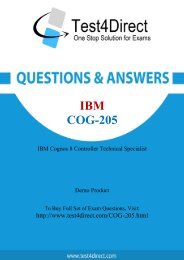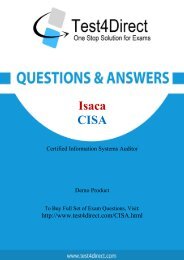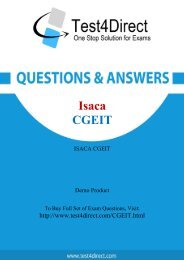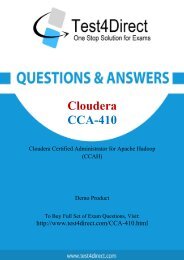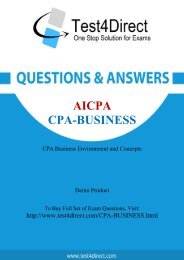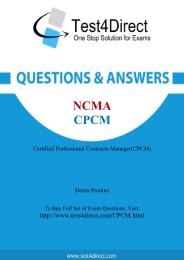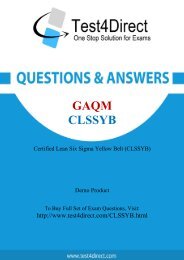CFA-Level-III Latest Exam BrainDumps
Test4Direct provides latest PDF questions of CFA Institute CFA-Level-III exam. You have an opportunity to pass the CFA Institute CFA-Level-III exam in one go. Test4Direct is most accurate source to prepare CFA Institute CFA-Level-III exam as your success will become site’s responsibility after purchasing CFA-Level-III exam product. There are also lots of discounts and promotion offers that you can avail. Let’s try a free demo http://www.test4direct.com/CFA-Level-III.html
Test4Direct provides latest PDF questions of CFA Institute CFA-Level-III exam. You have an opportunity to pass the CFA Institute CFA-Level-III exam in one go. Test4Direct is most accurate source to prepare CFA Institute CFA-Level-III exam as your success will become site’s responsibility after purchasing CFA-Level-III exam product. There are also lots of discounts and promotion offers that you can avail. Let’s try a free demo http://www.test4direct.com/CFA-Level-III.html
Create successful ePaper yourself
Turn your PDF publications into a flip-book with our unique Google optimized e-Paper software.
A. Calculate the required before-tax return for Beitia’s portfolio and Beitia’s expected utility from<br />
holding each of the corner portfolios.<br />
B. Assuming that Washington combines two corner portfolios to meet Beitia’s desired return<br />
(calculated in Part A), calculate the weights of the appropriate corner portfolios that will be used<br />
(assume no borrowing or short-selling) and the resulting portfolio standard deviation.<br />
C. Assuming that Washington combines a corner portfolio with the risk-free asset to meet Beitia’s<br />
desired return (calculated in Part A), calculate the weights of the appropriate corner portfolio and<br />
the risk-free asset that will be used (assume no borrowing) and the resulting portfolio standard<br />
deviation.<br />
Question: 3<br />
Question: 4<br />
Answer: B<br />
HAS THREE PARTS One year has passed since HNW Advisors first started operations. Their overall<br />
equity portfolio has returned 28.2% versus a return of 22.4% for the S&P 500. The standard deviation<br />
of the S&P 500 is 20%, and Maggie Day, <strong>CFA</strong>, has estimated the standard deviation of HNW Advisor’s<br />
equity portfolio at 45%. HNW Advisor’s equity portfolio has a beta of 1.35, and the risk-free rate is<br />
4.4%. A major HNW client is attempting to evaluate the relative performance of HNW’s equity fund.<br />
The client is unsure whether the Sharpe measure or the Treynor measure is appropriate for the HNW<br />
portfolio.<br />
A. Using the Sharpe and Treynor measures for the HNW portfolio and the S&P 500, determine how<br />
HNW has performed relative to the S&P 500.<br />
B. Assume that, using the Sharpe ratio to measure performance, the S&P 500 outperformed the<br />
HNW portfolio, but using the Treynor measure, the HNW portfolio outperformed the S&P 500.<br />
Explain, in terms of systematic and unsystematic risk, how this change in ranking could have<br />
occurred.<br />
C. Compute M2 for the HNW portfolio, assuming management uses the market as a benchmark.<br />
Explain, in terms of relative returns and volatility, the circumstances under which M2 for HNW would<br />
equal M2 for the market.<br />
Answer: B<br />
HAS TWO PARTS Tom Groh is the President of Opportunity Banks. Opportunity has historically<br />
operated in the northeastern United States, with most of its business in Maryland, Delaware, and<br />
New Jersey. Opportunity has been in business since 1987 and has built its business on making<br />
mortgages and construction loans to residential developers. Opportunity has been very profitable,<br />
because developers value the services the bank provides. This allows Opportunity to price their<br />
construction loans with higher interest rates. Opportunity services and retains ownership of the its<br />
loans. It historically has had a near-zero leverage-adjusted duration gap. In the most recent fiscal<br />
year, Opportunity has experienced important changes in their business as follows:<br />
1. Due to pressure from local activists, Opportunity has stepped up lending in low-income areas.<br />
Groh expects the default rate on these loans to be higher than the Loans currently in their portfolio.<br />
2. Opportunity has bought a regional bank with operations in North Carolina, South Carolina, and




